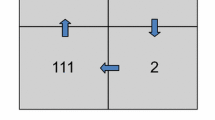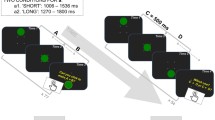Abstract
Predictions made by 4 competing models of time use by children with AD/HD were tested using a computerized version of the Matching Familiar Figures Test in 2 studies. In Study 1 teacher-identified AD/HD children (N = 10) and non-AD/HD controls (N = 10) completed the task under 3 different trial duration conditions (5, 10, and 15 s). In Study 2 the same task was completed by a group of children with a diagnosis of Hyperkinetic Disorder (N = 12) and controls (N = 12). In both studies AD/HD children performed poorly on trials of both 5- and 15-s duration but as well as controls on the 10-s trials. This quadratic function provided support for the State Regulation Deficit model of time use in AD/HD. The value of tailoring the temporal features of learning contexts to the conceptual style of AD/HD children is discussed.
Similar content being viewed by others
REFERENCES
Alberts, E., & Van der Meere, J. J. (1992). Observations of hyperactive behaviour during vigilance. Journal of Child Psychology and Psychiatry, 33, 1355–1364.
American Psychiatric Association. (1994). Diagnostic and statistical manual of mental disorders (4th ed.). Washington, DC: Author.
Antrop, I., Roeyers, H., Van Oost, P., & Buysse, A. (2000). Stimulation seeking and hyperactivity in AD/HD children. Journal of Child Psychology and Psychiatry, 41, 225–232.
Barnett, R., Maruff, P., Vance, A., Luk, E. S. L., Costin, J., Wood, C., et al. (2001). Abnormal executive function in attention deficit hyperactivity disorder: The effect of stimulant medication and age on spatial working memory. Psychological Medicine, 31, 1107–1115.
Borger, N., & Van der Meere, J. J. (2000). Visual behaviour of AD/HD children during an attention test: An almost forgotten variable. Journal of Child Psychology and Psychiatry, 35, 588–596.
Bronfenbrenner, U., & Ceci, S. J. (1994). Nature-nurture reconceptualized in developmental perspective—a bioecological model, Psychological Review, 101, 568–586.
Chee, P., Logan, G., Schachar, R., Lindsey, P., & Wachsmuth, R. (1989). Effects of event rate and display time on sustained attention in hyperactive, normal and control children. Journal of Abnormal Child Psychology, 17, 371–391.
Cirstea, M. C., & Levin, M. F. (2000). Compensatory strategies for reaching in stroke. Brain, 123, 940–953.
Conte, R., Kinsbourne, M., Swanson, J., Zirk, H., & Samuels, M. (1986). Presentation rate effects on pair associate learning by attention deficit disordered children. Child Development, 57, 681–687.
Cornoldi, C., Barbieri, A., Gaiani, C., & Zocchi, S. (1999). Strategic memory deficits in attention deficit disorder with hyperactivity participants: The role of executive processes. Developmental Neuropsychology, 15, 53–71.
Curran, S., Newman, S., Taylor, E., & Asherson, P. (2000). Hypescheme: An operational criteria checklist and minimum data set for molecular genetic studies of attention deficit and hyperactivity disorders. American Journal of Medical Genetics, 96, 244–250.
Dalby, J. T., Kinsbourne, M., & Swanson, J. M. (1989). Self-paced learning in children with attention deficit disorder with hyperactivity. Journal of Abnormal Child Psychology, 17, 269–275.
Dalby, J. T., Kinsbourne, M., Swanson, J., & Sobel, M. P. (1977). Hyperactive children under use of time: Correction by stimulant medication. Child Development, 44, 1448–1453.
Douglas, V.I. (1983). Attentional and cognitive problems. In M. Rutter (Ed.), Developmental Neuro-psychiatry. New York: Guilford.
Douglas, V. I., & Peters, K. G. (1979). Towards a clearer definition of attentional deficit in hyperactive children. In G. A. Hale & M. Lewis (Eds.), Attention and the development of cognitive skills. New York: Plenum.
Elliott, C. D. (1983a). British Ability Scales: Manual 1. Windsor: NFER-Nelson.
Elliott, C. D. (1983b). British Ability Scales: Manual 2. Windsor: NFER-Nelson.
Frank, Y., Seiden, J., & Napolitano, B. (1996). Visual event-related potentials and reaction in normal adults, normal children and children with attention deficit hyperactivity disorder: Differences in short-term memory processing. International Journal of Neuroscience, 88, 109–124.
Goodman, R. (1997). The strengths and difficulties questionnaire: A research note. Journal of Child Psychology and Psychiatry, 38, 581–586.
Gottlieb, G. (1991). Experiential canalization of behavioural-development theory. Developmental Psychology, 27, 4–13.
Kagan, J. (1965). Reflection-impulsivity and reading ability in primary grade children. Child Development, 36, 609–628.
Karatekin, C., & Asarnow, R. F. (1998). Working memory in childhood onset schizophrenia and attention deficit/hyperactivity disorder. Psychiatry Research, 80, 165–176.
Little, T. D. (2000). The millennial challenge: Modelling the agentic self in context. International Journal of Behavioural Development, 24, 149–152.
Nation, K., & Snowling, M. J. (1998). Individual differences in contextual facilitation: Evidence from dyslexia and poor reading comprehension. Child Development, 69, 996–1011.
Nigg, J. (2001). Is ADHD a disinhibitory disorder? Psychological Bulletin, 127, 571–598.
Rubia, K., Taylor, A., Taylor, E., & Sergeant, J. A. (1999). Synchronization, anticipation, and consistency in motor timing of children with dimensionally defined attention deficit hyperactivity behaviour. Perceptual and Motor Skills, 89, 1237–1258.
Rutter, M. (1967). A childrens' behaviour questionnaire for completion by teachers: Preliminary findings. Journal of Child Psychology and Psychiatry, 8, 1–11.
Schweitzer, J. B., Faber, T. L., Grafton, S. T., Tune, L. E., Hoffman, J. M., & Kilts, C. D. (2000). Alternations in the functional anatomy of working memory in adult attention deficit hyperactivity disorder. American Journal of Psychiatry, 157, 278–280.
Seidman, L. J., Beiderman, J., Faraone, S. V., Wever, W., & Ouellette, C. (1997). Toward defining a neuropsychology of attention deficit-hyperactivity disorder: Performance of children and adolescents from a large clinically referred sample. Journal of Consulting and Clinical Psychology, 65, 150–160.
Sergeant, J. (2000). The cognitive-energetic model: An empirical approach to attention-deficit hyperactivity disorder. Neuroscience and Biobehavioral Reviews, 24, 7–12.
Sonuga-Barke, E. J. S. (1994). On dysfunction and function in psychological accounts of childhood disorder. Journal of Child Psychology and Psychiatry, 35, 801–815.
Sonuga-Barke, E. J. S. (in press). Psychological Heterogeneity in AD/HD: A dual pathway model of behaviour and cognition. Behavioural Brain Research.
Sonuga-Barke, E. J. S., Houlberg, K., & Hall, M. (1994). When is impulsiveness not impulsiveness?: The case of children's cognitive style. Journal of Child Psychology and Psychiatry, 35, 1247–1253.
Sonuga-Barke, E. J. S., & Taylor, E. (1992). The effect of delay on hyperactive and nonhyperactive childrens response-times. Journal of Child Psychology and Psychiatry, 33, 1091–1096.
Sonuga-Barke, E. J. S., Williams, E., Hall, M., & Saxton, T. (1996). Hyperactivity and delay aversion III: The effect on cognitive style of imposing delay after errors. Journal of Child Psychology and Psychiatry, 37, 189–194.
Swanson, J., Sergeant, J., Taylor, E., Sonuga-Barke, E. J. S., Jensen, P., & Cantwell, D. (1998). Attention deficit hyperactivity disorder and hyperkinetic disorder. The Lancet, 351, 429–433.
Van der Meere, J. J. (1996). The role of inattention in hyperactivity disorders. In S. Sandberg (Ed.), Monographs on child and adolescent psychiatry: Hyperactivity disorders. Cambridge: Cambridge University Press.
Van der Meere, J., Gunning, B., & Stemerdink, N. (1999). The effect of methylphenidate and clonodine on response inhibition and state regulation in children with AD/HD. Journal of Child Psychology and Psychiatry, 40, 291–298.
Van der Meere, J., Stemerdink, N., & Gunning, B. (1995). Efects of presentation rate of stimuli on response-inhibition in AD/HD children with and without tics. Perceptual and Motor Skills, 81, 259–262.
Walczyk, J. J. (1995). Testing a compensatory-encoding model. Reading Research Quarterly, 30, 396–408.
World Health Organisation. (1992). Mental and behavioural disorders. Diagnostic criteria for research. In International classification of diseases (10th Ed.). Geneva, Switzerland: Author.
Zec, R. F. (1995). The neuropsychology of aging. Experimental Gerontology, 30, 431–442.
Author information
Authors and Affiliations
Corresponding author
Rights and permissions
About this article
Cite this article
Sonuga-Barke, E.J.S. Interval Length and Time-Use by Children with AD/HD: A Comparison of Four Models. J Abnorm Child Psychol 30, 257–264 (2002). https://doi.org/10.1023/A:1015154829796
Issue Date:
DOI: https://doi.org/10.1023/A:1015154829796




